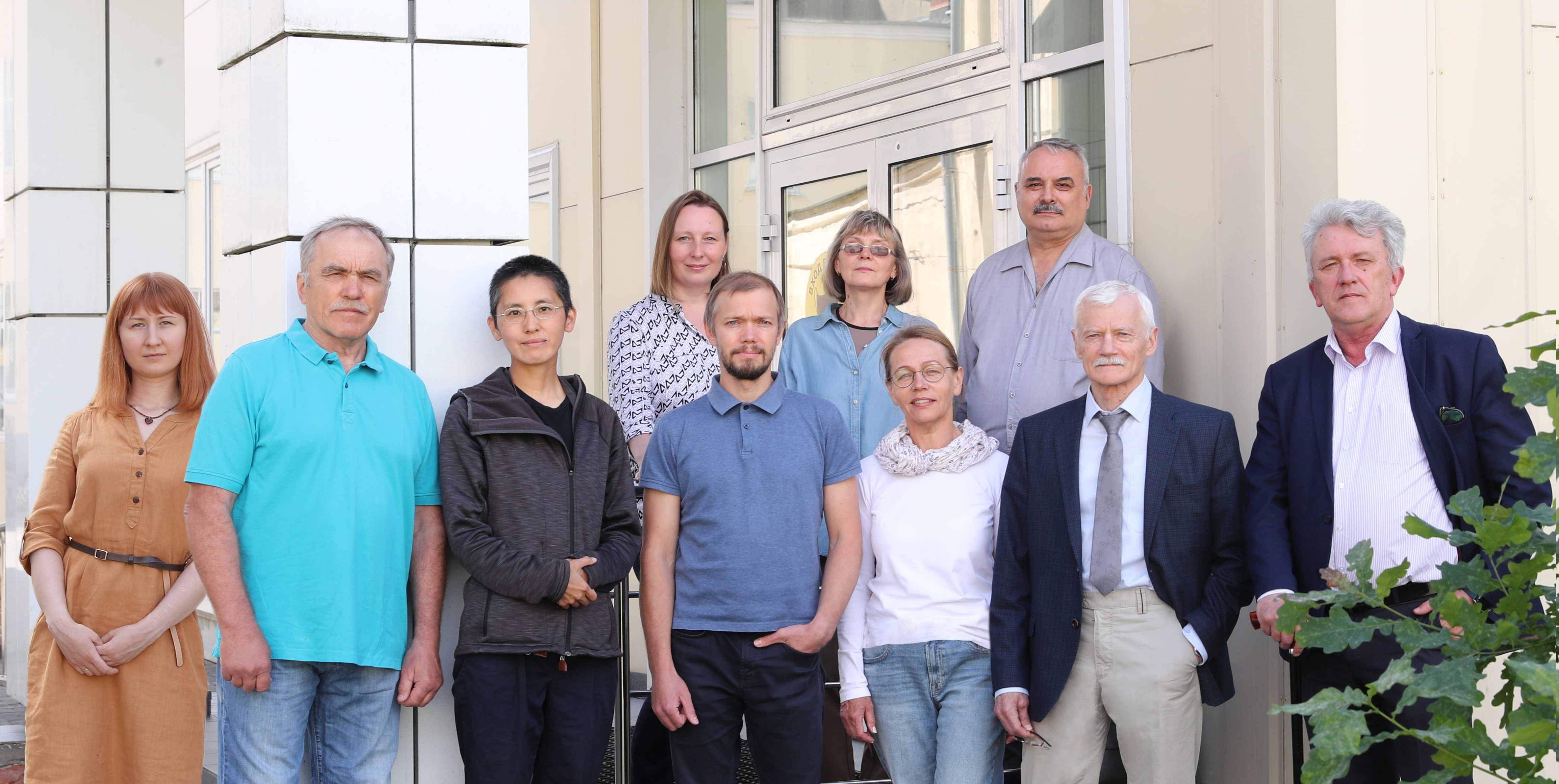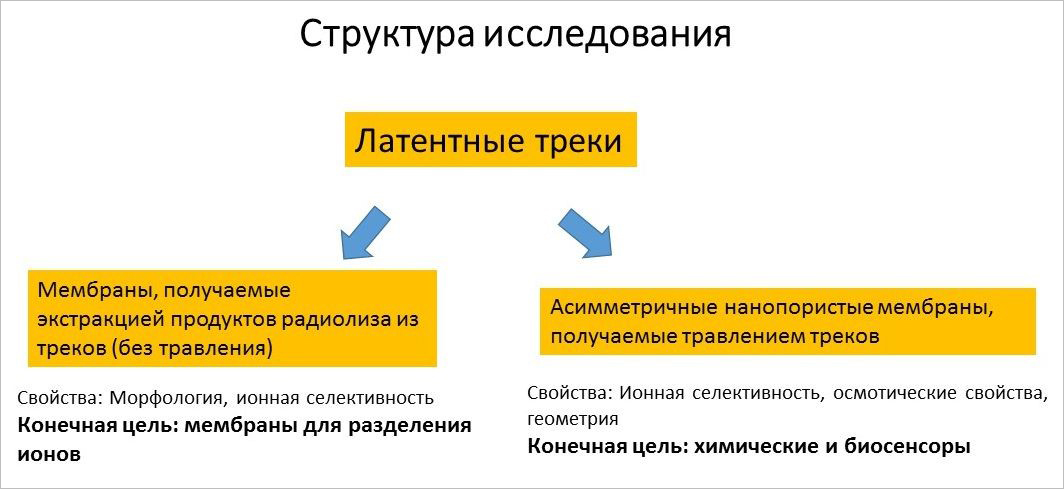Development of ion-selective track membranes for nanosensors and electrodialysis
News, 28 October 2022
Scientists from the Laboratory of Nuclear Reactions JINR carried out a cycle of research, which led to the development of methods for obtaining practically important nanoporous objects – ion-selective asymmetric membranes for nanosensors and membranes for electrodialysis. In particular, this involves a new technique for directly observing the hidden tracks of heavy ions and a method for producing asymmetric nanopores in the right way. Scientists have also gained an in-depth understanding of the properties of track membranes with nanometre pores. For example, it was shown for the first time that structures with capillary pores could show pronounced osmotic behaviour in dilute salt solutions. In practice, these results are useful for electrodialysis and the creation of nanosensors.
Track membranes have existed for more than half a century, and for most of that time, they have been used for microfiltration and ultrafiltration. Areas of application were various – analytical work, water purification, purification of virus suspensions, purification of medical preparation, work with cell cultures. At the same time, physical essence of the processes provided by track membranes was the separation of suspended particles from the dispersion area. The rapid development of nanotechnologies and life sciences in recent decades has posed many new challenges to researchers, including those in the field of membrane science.
The so-called ion channels play an immense role in the functioning of living systems. Understanding how these nanometre channels work is crucial, as they perform a variety of specific functions. Therefore, one of the challenges both for theorists and experimentalists has been to create artificial analogues of ion channels. Based on the fact that the interaction of a high-energy ion with substance is concentrated in nanometre volumes, JINR scientists began research and development in a new direction.
 Bottom row from left to right: Pavel Apel, Oleg Ivanov, Olga Kristavchuk, Nikolay Lizunov, Alexander Nechaev, Olga Polezhaeva, Yukari Yamauchi. Top row from left to right: Irina Blonskaya, Katarzyna Olejniczak, Oleg Orelovich
Bottom row from left to right: Pavel Apel, Oleg Ivanov, Olga Kristavchuk, Nikolay Lizunov, Alexander Nechaev, Olga Polezhaeva, Yukari Yamauchi. Top row from left to right: Irina Blonskaya, Katarzyna Olejniczak, Oleg Orelovich
“Now track membranes have been viewed not just as a kind of sieve to separate suspended particles, but as a system that provides controlled transport of ions and molecules,” Pavel Apel, Director of the Centre of Applied Physics at the Laboratory of Nuclear Reactions JINR, commented on the essence of the new approach to research. Thus, the new approach assumes that all key experiments are carried out with pores in the nanometre range.
A team of JINR researchers develops ion-selective membranes by bombarding thin polymer films with accelerated heavy ions. In practical terms, such membranes can serve two types of purposes. The first is the separation of ions via electrodialysis and the second is the development of nanosensors based on the resistive pulse principle. To understand exactly how the films will be used in practice, an in-depth understanding of the properties of nanometre pore track membranes is required. A cycle of investigations by JINR scientists was devoted to this task (Fig. 1).
Passing through the film of irradiated material, the heavy ion forms a channel of strong radiation damage. “In these channels, the irradiated polymer molecules are broken up and split into smaller fragments. By interacting with the irradiated matter, the heavy ion loses part or all of its energy and produces a radiative disruption of the matter along the track. As a result, a field of matter with an altered structure is formed, which generally has an increased chemical solubility. Such an area is called a latent, that is, a hidden track,” Pavel Apel explains. Since polymers are quite stable to temperature and humidity, the latent track area can persist for many years.
First of all, scientists need a deep insight into the nature and structure of heavy ion tracks in polymer. The FLNR JINR team has developed a method [1], which allowed the first direct observation of latent heavy ion tracks in a semicrystalline polymer using scanning electron microscopy. For this purpose, a controlled soft photo-oxidation of amorphous phase of the polymer was performed. As a result, the sample prepared by this technique exhibits a sharp contrast between the structure of the pristine polymer and the amorphised and partially degraded track zone. Scientists were able to obtain images of tracks of ions with energy losses dE/dx from 7 to 20 keV/nm in polyethylene terephthalate and polypropylene. The transverse size of the track halo was determined, which was previously inaccessible to direct observation, and information about its nature and radial extent was only obtained by other methods.
JINR scientists have studied how the properties of latent track as an amorphous inclusion that contains low-molecular radiolysis products can be applied to produce ion-selective membranes from PET films irradiated with heavy ions, and have determined the critical parameters of this process [2]. They showed that an ion-exchange membrane, selective to cations, can be fabricated from a monolithic polymer film using liquid extraction of radiolysis and photolysis products from tracks. The properties of the obtained membranes are shown to depend on the mass of bombarding ion, pH and temperature of extracting medium. Due to high concentration of carboxyl groups, capable of dissociation, the membrane possesses ionic selectivity in electrolyte solutions. The selectivity and permeability drastically change when halos of individual tracks overlap. Thus, it is shown that the latent tracks, being modified by the extraction, are responsible for the ionic transport.
Two factors are determining for the ionic transport – free volume and high concentration of carboxyl groups. In fact, the modified tracks constitute nanosized chromatography columns filled with an electrically charged gel. The transport occurs through the subnanometer channels in the gel, due to which hydrated cations of a smaller size (K+) migrate faster than Li+ and Mg2+. The results have shown that the extracted track membranes – in addition to conventional application areas of track-etched membranes (ultrafiltration and microfiltration) – have a potential for the use in electrodialysis, i.e. for the separation of ions. Scientists continue research work on the optimization of ion-selective track membranes to be able to separate Li+ ions.
 Fig. 2. Evolution of the nanopore mouth during asymmetric etching. Configurations (A-D) can be used as elements of a resistive pulse sensor for large molecules and particles such as viruses. Each image is 1000 nm wide
Fig. 2. Evolution of the nanopore mouth during asymmetric etching. Configurations (A-D) can be used as elements of a resistive pulse sensor for large molecules and particles such as viruses. Each image is 1000 nm wide
The research team studied osmosis in negatively charged nanocapillaries and its enhancement by an anionic surfactant [3]. It should be reminded that osmosis is a process of one-way transportation of solution through a semipermeable membrane towards a higher concentration of solute. On the example of cylindrical track pores 10-25 nm in radius it was first demonstrated that not only monolithic semipermeable membranes (as it is customary to think), but also capillary pores can show pronounced osmotic behaviour in diluted salt solutions. The study showed that, in the presence of electrolyte concentration gradient, the osmotic forces occur due to electrostatic interaction between ions and charged surface of pores. Conclusions drawn in [3] are used in [4, 5] for finding out mechanisms of asymmetric pore etching in polymer films and for optimization of the process.
Nowadays, asymmetric nanopores with mouths of 3-20 nm are an object of great interest. The reason is their unique properties, such as ionic selectivity and diode-like behaviour, and versatile potential applications in nanosensorics, nanofluidics, and medical diagnostics. The osmotic effects in nanopores produced by track etching have also been studied in this direction [4]. Scientists have shown that the concentration gradient under conditions of asymmetric etching generates an osmotic flux of neutralising solution opposite to the diffusion flux of etching agent. In order to find interrelations that govern pore formation under the conditions of this physicochemical experiment [5], measurements of electric current through single pores and arrays of pores, diffusion flux of etching agent and osmotic counter-flux were measured in the course of asymmetric etching. It was found that at the initial stage the pore geometry is governed by the diffusion-controlled nonlinear gradient of etchant concentration. Later, an osmotic flux arises, and the change in the balance between the diffusion and convection leads to the modification of the longitudinal profile of the channel.
Thus, estimates of the reflection coefficient responsible for the osmotic flow were obtained. Scientists have determined that the application of electric field is another factor for the control over the shape of asymmetric channel. Evolution of the nanochannel geometry is supported by electron microscopy images (see Fig. 2). The main result of this study is the method that allows, within the frame of the same procedure, fabrication of asymmetric nanopores of different configurations. First of all, these nanopores are applicable in the technique of biosensors.
A series of papers by JINR scientists on the development of ion-selective membranes for nanosensors and electrodialysis (authors: P.Y. Apel. I.V. Blonskaya, O.M. Ivanov, O.V. Kristavchuk, N.E. Lizunov, A.N. Nechaev, K. Olejniczak, O.L. Orelovitch, O.A. Polezhaeva, Yu. Yamauchi) was awarded the second JINR Prize for Applied Physics Research.
References:
- I.V. Blonskaya, O.V. Kristavchuk, A.N. Nechaev, O.L. Orelovich, O.A. Polezhaeva, P.Y. Apel. Observation of latent ion tracks in semicrystallime polymers by scanning electron microscopy. J. Appl. Polym. Sci. 138 (2021) art. 49869.
- Apel, P.Y., Blonskaya, I.V., Ivanov, O.M., O.V. Kristavchuk, N.E. Lizunov, A.N. Nechaev, O.L. Orelovich, O.A. Polezhaeva, S.N. Dmitriev. Creation of Ion-Selective Membranes from Polyethylene Terephthalate Films Irradiated with Heavy Ions: Critical Parameters of the Process. Membr. Membr. Technol. 2, 98–108 (2020).
- Yu. Yamauchi, I.V. Blonskaya, P.Yu. Apel. Osmosis in Negatively Charged Nanocapillaries and Its Enhancement by an Anionic Surfactant. Colloid Journal, 80 (2018) 792–802.
- P.Y. Apel. I.V. Blonskaya, N.E. Lizunov, K. Olejniczak, O.L. Orelovitch, M.E. Toimil-Molares, C. Trautmann. Osmotic Effects in Track-Etched Nanopores, Small 14 (2018) 1703327 (10 pp).
- I.V. Blonskaya, N.E. Lizunov, K. Olejniczak, O.L. Orelovich, Y. Yamauchi, M.E. Toimil-Molares, C. Trautmann, P.Y. Apel. Elucidating the roles of diffusion and osmotic flow in controlling the geometry of nanochannels in asymmetric track-etched membranes. J. Membr. Sci. 618 (2021) 118657.
